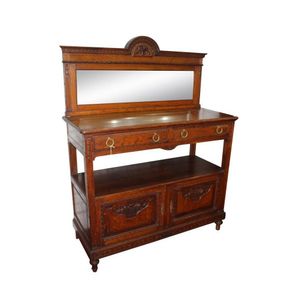French Oak Mirror Back Sideboard, Early 20th Century, 155cm x120cm
French oak mirror back sideboard, early 20th century, featuring a rectangular mirrored back set with an arched pediment, above twin pull out drawers with ring loop drops, with second tier set above twin doors carved with floral baskets, on turned spindle legs, 155 cm x 120 cm x 51 cm
You must be a subscriber, and be logged in to view price and dealer details.
Subscribe Now to view actual auction price for this item
When you subscribe, you have the option of setting the currency in which to display prices to $Au, $US, $NZ or Stg.
This item has been sold, and the description, image and price are for reference purposes only.
- Turning - Any part of a piece of furniture that has been turned and shaped with chisels on a lathe. Turned sections include legs, columns, feet, finials, pedestals, stretchers, spindles etc. There have been many varieties and fashions over the centuries: baluster, melon, barley-sugar, bobbin, cotton-reel, rope-twist, and so on. Split turning implies a turned section that has been cut in half lengthwise and applied to a cabinet front as a false decorative support.
- Pediment - The uppermost section of a tall usually double-heightened piece of cabinet furniture, surmounting the cornice. The pediment can take a variety of forms derived from the architecture of classical antiquity. A broken pediment is of triangular shape, however, the two raised sides do not meet at the apex but are 'broken' the gap between them often ornamented with an urn or finial. Swan-neck pediments are of similar form, although the uprights are gracefully arched, resembling a swan's neck. They are often found, for example, on longcase clocks.
- Oak - Native to Europe and England, oak has been used for joinery, furniture and building since the beginning of the medieval civilisation. It is a pale yellow in colour when freshly cut and darkens with age to a mid brown colour.
Oak as a furniture timber was superceded by walnut in the 17th century, and in the 18th century by mahogany,
Semi-fossilised bog oak is black in colour, and is found in peat bogs where the trees have fallen and been preserved from decay by the bog. It is used for jewellery and small carved trinkets.
Pollard oak is taken from an oak that has been regularly pollarded, that is the upper branches have been removed at the top of the trunk, result that new branches would appear, and over time the top would become ball-like. . When harvested and sawn, the timber displays a continuous surface of knotty circles. The timber was scarce and expensive and was used in more expensive pieces of furniture in the Regency and Victorian periods. - Tier - One or more under-shelves of a table or cabinet.
This item has been included into following indexes:
- cabinets, material - oak 563
- cabinets, period or style - French 732
-
sideboards
- mirror back 139
- oak 132
